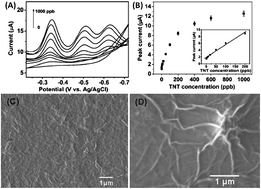Nanomaterial-based electrochemical detection of explosives: a review of recent developments
Abstract
This article reviews recent advances in electrochemical sensing and detection of explosive substances at nanomaterial-based electrode surfaces. The escalating threat of terrorist activities and growing environmental concerns have generated major demand for innovative, field-deployable tools for detecting explosives in a fast, sensitive, reliable and simple manner. Electrochemical sensors can address these demands as they possess attributes including high sensitivity and selectivity, speed, wide linear range, compatibility with microfabrication, minimal space and power requirements, and low-cost instrumentation. The redox properties of nitro-based explosives, namely the presence of easily reducible nitro groups, ideally lend themselves to electrochemical detection. Advances in the development of nanomaterials show strong potential to create electrochemical sensors for detecting explosives, with aspects such as very high surface area-to-volume ratio, convergent rather than linear diffusion, improved selectivity, catalytic activity, and unique electrical and optical properties which can be exploited for highly sensitive molecular adsorption detection. The goal of this article is to review recent advances in electrochemical detection of nitro-based explosives at working electrodes comprised of different nanomaterials. Specifically we will discuss the electroanalysis of nitro-based explosives on graphene, carbon nanotubes, nanoparticles and nanoporous material, and composites of these materials.


 Please wait while we load your content...
Please wait while we load your content...